Crank J. Free and Moving Boundary Problems
Подождите немного. Документ загружается.

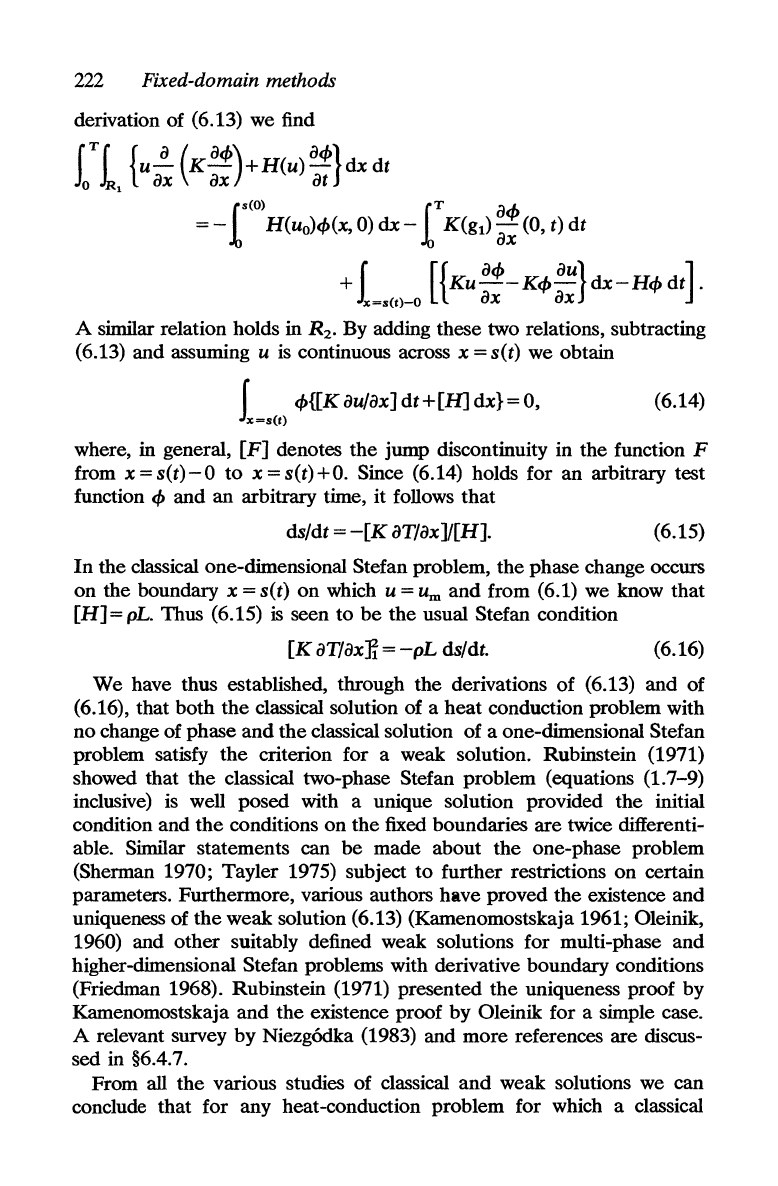
222
Fixed-domain methods
derivation of (6.13) we find
I
Ti
{u.i.
(Ka<b)+H(U)
a<b}dX
dt
o 1
ax ax
at
1
8(0)
IT
a<b
= -
H(uo)<b(x,
0) dx -
K(gt)
ax (0, t) dt
+ 1 [{KU
a<b
-
K<b
au} dx -
H<b
dt] .
=.(1)-0
ax ax
A similar relation holds in R
z
.
By
adding these two relations, subtracting
(6.13)
and
assuming U is continuous across x = s(t) we obtain
1=8(t)
<b{[K
au/ax] dt+[H] dx}= 0,
(6.14)
where, in general,
[F]
denotes
the
jump
discontinuity in
the
function F
from x =
s(t)-O
to
x = s(t)+O. Since (6.14) holds for
an
arbitrary test
function
<b
and
an
arbitrary time, it follows
that
ds/dt =
-[K
aT/ax]/[H].
(6.15)
In
the
classical one-dimensional Stefan problem,
the
phase
change occurs
on
the
boundary x = s(t)
on
which U = Urn
and
from (6.1) we know
that
[H]
= pL. Thus (6.15)
is
seen
to
be
the
usual Stefan condition
[K
aT/axli =
-pL
ds/dt. (6.16)
We
have thus established, through
the
derivations
of
(6.13)
and
of
(6.16), that
both
the
classical solution
of
a
heat
conduction problem with
no
change
of
phase
and
the
classical solution
of
a one-dimensional Stefan
problem satisfy
the
criterion for a weak solution. Rubinstein (1971)
showed
that
the
classical two-phase Stefan
problem
(equations (1.7-9)
inclusive) is well
posed
with a unique solution provided
the
initial
condition
and
the
conditions
on
the
fixed boundaries
are
twice differenti-
able. Similar statements can
be
made
about
the
one-phase problem
(Sherman 1970; Tayler 1975) subject
to
further restrictions
on
certain
parameters. Furthermore, various authors have
proved
the
existence
and
uniqueness of
the
weak
solution (6.13) (Kamenomostskaja 1961; Oleinik,
1960) and
other
suitably defined weak solutions for multi-phase
and
higher-dimensional Stefan problems with derivative boundary conditions
(Friedman 1968). Rubinstein (1971) presented
the
uniqueness proof by
Kamenomostskaja
and
the
existence proof
by
Oleinik for a simple case.
A relevant survey
by
Niezg6dka (1983) and
more
references
are
discus-
sed
in §6.4.7.
From all
the
various studies
of
classical
and
weak
solutions we can
conclude
that
for any heat-conduction
problem
for which a classical
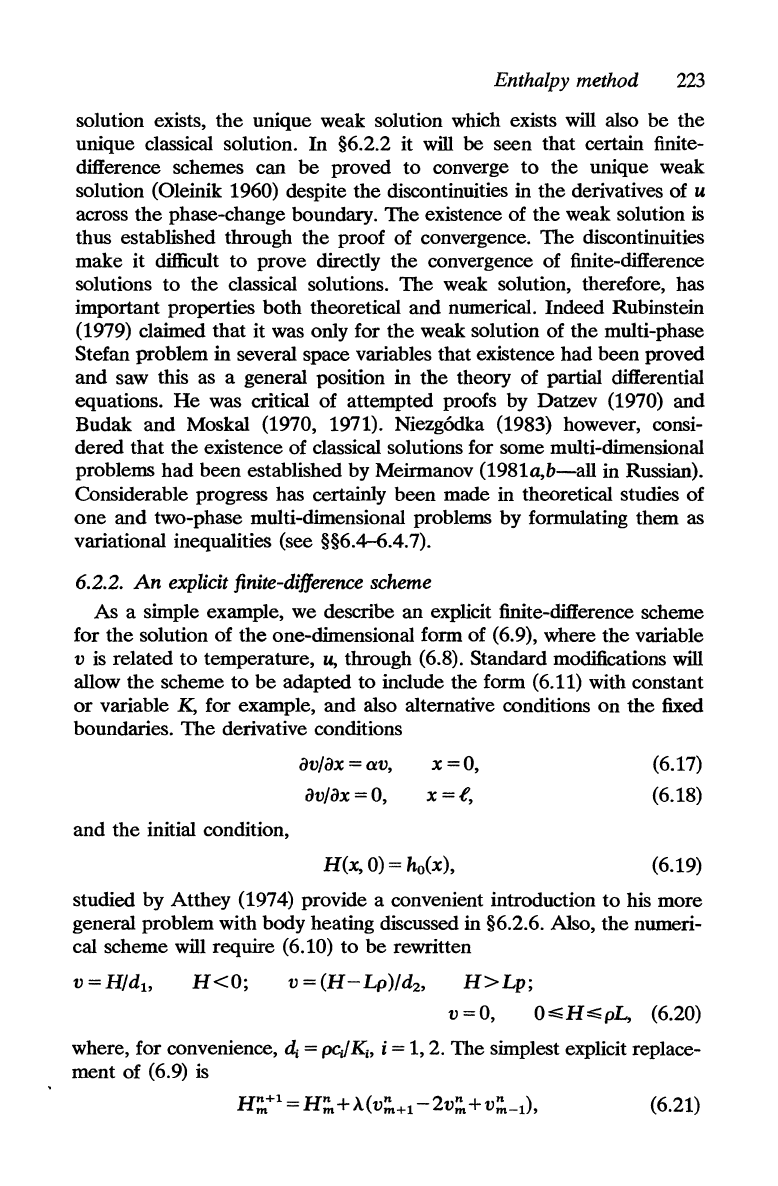
Enthalpy method
223
solution exists,
the
unique weak solution which exists will also
be
the
unique classical solution.
In
§6.2.2 it will be seen that certain finite-
difference schemes can
be
proved
to
converge
to
the unique weak
solution (Oleinik 1960) despite the discontinuities in
the
derivatives of u
across
the
phase-change boundary.
The
existence of
the
weak solution is
thus established through
the
proof of convergence.
The
discontinuities
make it difficult
to
prove directly
the
convergence of finite-difference
solutions
to
the classical solutions.
The
weak solution, therefore, has
important properties
both
theoretical
and
numerical. Indeed Rubinstein
(1979) claimed that it was only for
the
weak solution of
the
multi-phase
Stefan problem in several space variables that existence
had
been proved
and
saw this as a general position in
the
theory of partial differential
equations.
He
was critical of attempted proofs by Datzev (1970) and
Budak
and
Moskal (1970, 1971). NiezgOdka (1983) however, consi-
dered that
the
existence of classical solutions for some multi-dimensional
problems
had
been established by Meirmanov
(1981a,b-all
in Russian).
Considerable progress has certainly been made in theoretical studies of
one
and
two-phase multi-dimensional problems
by
formulating them as
variational inequalities (see §§6.4-6.4.7).
6.2.2.
An
explicit finite-difference scheme
As
a simple example, we describe an explicit finite-difference scheme
for
the
solution of
the
one-dimensional form of (6.9), where the variable
v is related
to
temperature,
u,
through (6.8). Standard modifications will
allow
the
scheme
to
be
adapted
to
include the form (6.11) with constant
or
variable
K,
for example,
and
also alternative conditions
on
the
fixed
boundaries.
The
derivative conditions
and
the
initial condition,
iJv/iJx=av,
iJv/iJx=O,
x=O,
x=t,
H(x,
0) = ho(x),
(6.17)
(6.18)
(6.19)
studied by Atthey (1974) provide a convenient introduction
to
his more
general problem with body heating discussed in §6.2.6. Also,
the
numeri-
cal scheme will require (6.10)
to
be
rewritten
v=H/d
b
H<O;
v=(H-Lp)/d
2
,
H>Lp;
v=O,
O~H~pL,
(6.20)
where, for convenience,
d;
=
pc;/
K;,
i = 1, 2.
The
simplest explicit replace-
ment of (6.9) is
(6.21)
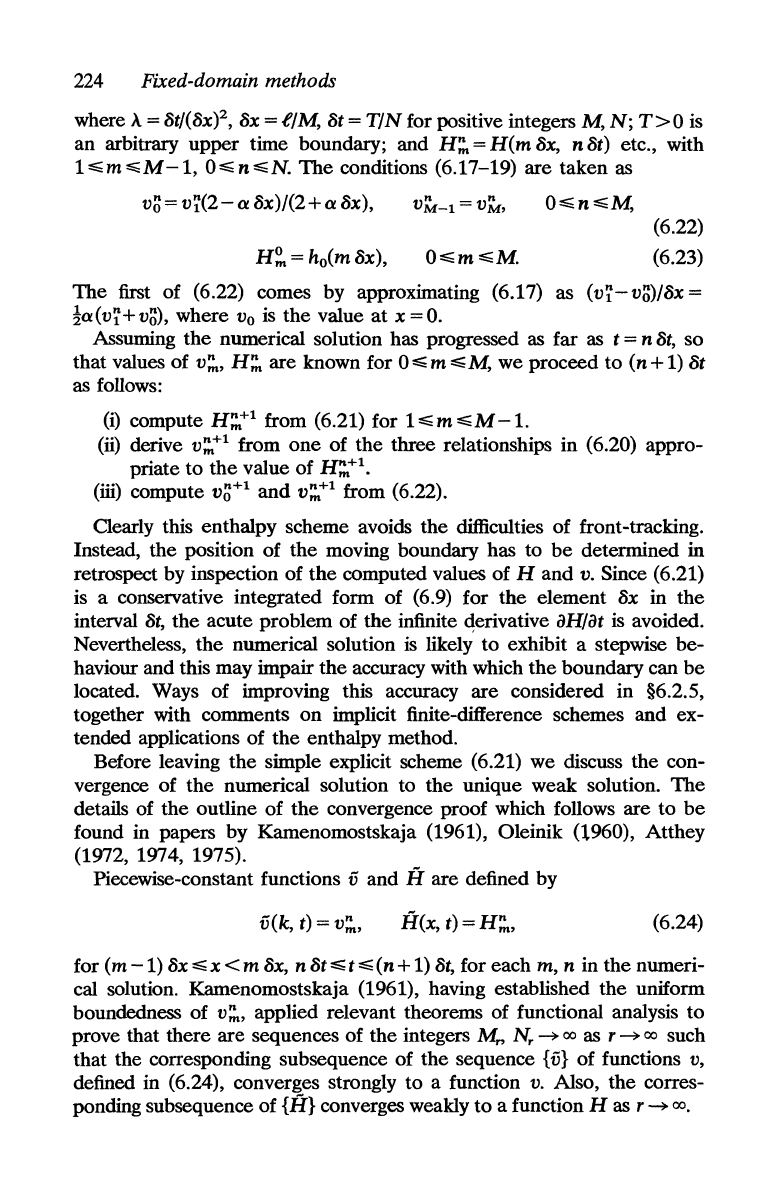
224 Fixed-domain methods
where A = 8t/(8x)2,
8x
=
elM,
8t
=
T/N
for positive integers M,
N;
T>O
is
an arbitrary
upper
time boundary; and H;:' =
H(m
8x, n
8t)
etc., with
1-=:;m-=:;M-1,
O-=:;n-=:;N.
The
conditions (6.17-19) are taken as
v(j=vl'(2-a8x)/(2+a8x),
VM-l
=VM,
O~n-=:;M,
O-=:;m-=:;M.
(6.22)
(6.23)
The
first of (6.22) comes by approximating (6.17) as
(vl'-v(j)/8x
=
~a(vl'+v(j),
where
Vo
is
the
value
at
x=O.
Assuming
the
numerical solution has progressed
as
far
as
t = n 8t,
so
that values of v;:', H;:' are known for 0
-=:;
m
-=:;
M, we proceed
to
(n
+ 1)
8t
as follows:
(i)
compute H;:.+1 from (6.21) for
l-=:;m-=:;M-1.
(ii)
derive
v;:.+1
from
one
of the three relationships in (6.20) appro-
priate
to
the
value
of
H;:.+l.
(iii) compute
v(j+1
and
V;:'+l from (6.22).
Clearly this enthalpy scheme avoids
the
difficulties of front-tracking.
Instead, the position of
the
moving boundary has to
be
determined in
retrospect by inspection of
the
computed values of
Hand
v.
Since (6.21)
is a conservative integrated form of (6.9) for
the
element
8x
in
the
interval 8t,
the
acute problem of
the
infinite qerivative iJH/iJt is avoided.
Nevertheless,
the
numerical solution is likely
to
exhibit a stepwise be-
haviour and this may impair
the
accuracy with which
the
boundary can
be
located. Ways of improving this accuracy are considered in §6.2.5,
together with comments
on
implicit finite-difference schemes and ex-
tended applications of
the
enthalpy method.
Before leaving
the
simple explicit scheme (6.21) we discuss
the
con-
vergence of
the
numerical solution to
the
unique weak solution.
The
details of
the
outline of
the
convergence proof which follows are
to
be
found in papers
by
Kamenomostskaja (1961), Oleinik (1960), Atthey
(1972, 1974, 1975).
Piecewise-constant functions
f5
and H are defined by
f5(k,
t) =
v;:',
H(x,
t) = H;:',
(6.24)
for
(m
-1)
8x-=:;x
<m
8x, n 8t-=:;t-=:;(n+ 1) 8t, for each m, n in
the
numeri-
cal solution. Kamenomostskaja
(1961), having established
the
uniform
boundedness of
v;:', appJied relevant theorems of functional analysis
to
prove that there are sequences of
the
integers
M..
N
r
~
00
as r
~
00
such
that the corresponding subsequence of
the
sequence
{f5}
of functions v,
defined in (6.24), converges strongly
to
a function
v.
Also, the corres-
ponding subsequence of
{H}
converges weakly
to
a function H
as
r
~
00.
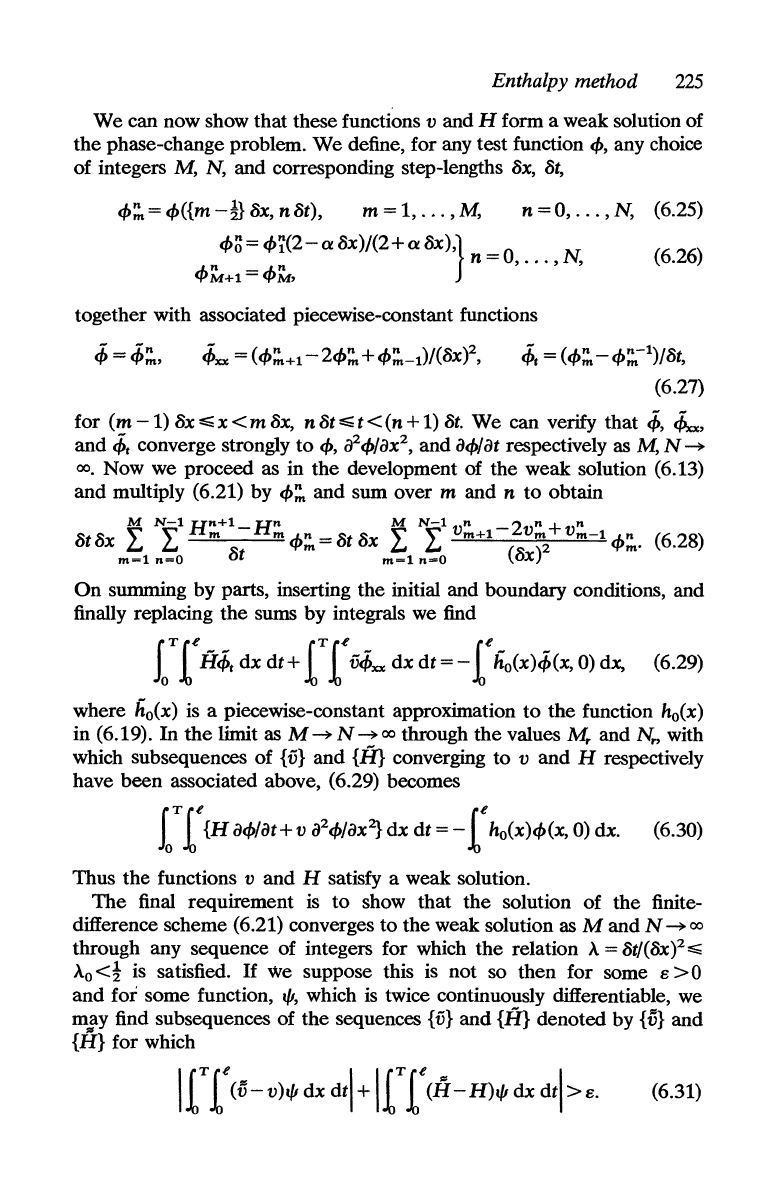
Enthalpy method
225
We
can now show
that
these functions v and H form a
weak
solution of
the
phase-change problem.
We
define, for any test function
<1>,
any choice
of integers M, N, and corresponding step-lengths
Sx,
St,
<1>;:'
=
<I>({m
-n
Sx,
n St),
m=l,
...
,M,
n = 0,
...
,N,
(6.25)
<1>0=
<1>7(2-0:
Sx)/(2+0:
SX),}
n = 0,
...
,N,
<I>~+1
=<I>~,
together with associated piecewise-constant functions
(6.26)
cf,
=
cf,;:.,
cf,t
=
(<I>;:'
-<I>r:.;l)/St,
(6.27)
for (m
-1)
Sx';;;;x
<m
Sx,
n
St.;;;;t«n
+
1)
St.
We
can verify
that
cf"
<bx,.,
and
~
converge strongly
to
<1>,
ii<l>/ax
2
,
and
a<l>/at
respectively as
M,
N
~
00.
Now we proceed as
in
the
development of
the
weak solution (6.13)
and
multiply (6.21) by
<1>;:'
and
sum
over m and n
to
obtain
M
N-l
Hn+1
Hn
M
N-l
n 2 n + n
St
Sx
L L m - m
<1>;:'
=
St
Sx
L L
Vm+l
- v
m2
V
m
-l
<1>;:'.
(6.28)
m=l
n=O
St
m=l
n=O
(Sx)
On
summing
by
parts, inserting
the
initial and boundary conditions, and
finally replacing
the
sums
by
integrals we find
IT
r
ilcf,t
dx
dt
+ 1 T r
vcf,xx
dx
dt
= - r ho(x )
cf,
(x, 0) dx, (6.29)
where ho(x) is a piecewise-constant approximation
to
the
function ho(x)
in
(6.19).
In
the
limit as M
~
N
~
00
through
the
values
Mr
and
N..,
with
which subsequences
of
{v}
and
{if}
converging to v
and
H respectively
have
been
associated above, (6.29) becomes
IT
r{H
a<l>/at+v
a
2
<1>/ax'1)
dx
dt
= - r ho(x)
<I>
(x,
0) dx. (6.30)
Thus
the
functions v
and
H satisfy a weak solution.
The
final requirement is
to
show
that
the
solution
of
the
finite-
difference scheme (6.21) converges
to
the
weak solution as M
and
N
~oo
through any sequence of integers for which
the
relation A =
St/(Sx)2.;;;;
Ao<! is satisfied.
If
We
suppose this is not so
then
for some B
>0
and
for
some function,
I/J,
which is twice continuously differentiable, we
may find subsequences
of
the
sequences
{il}
and
{il} denoted by
{ti}
and
'"
{H}
for which
(6.31)
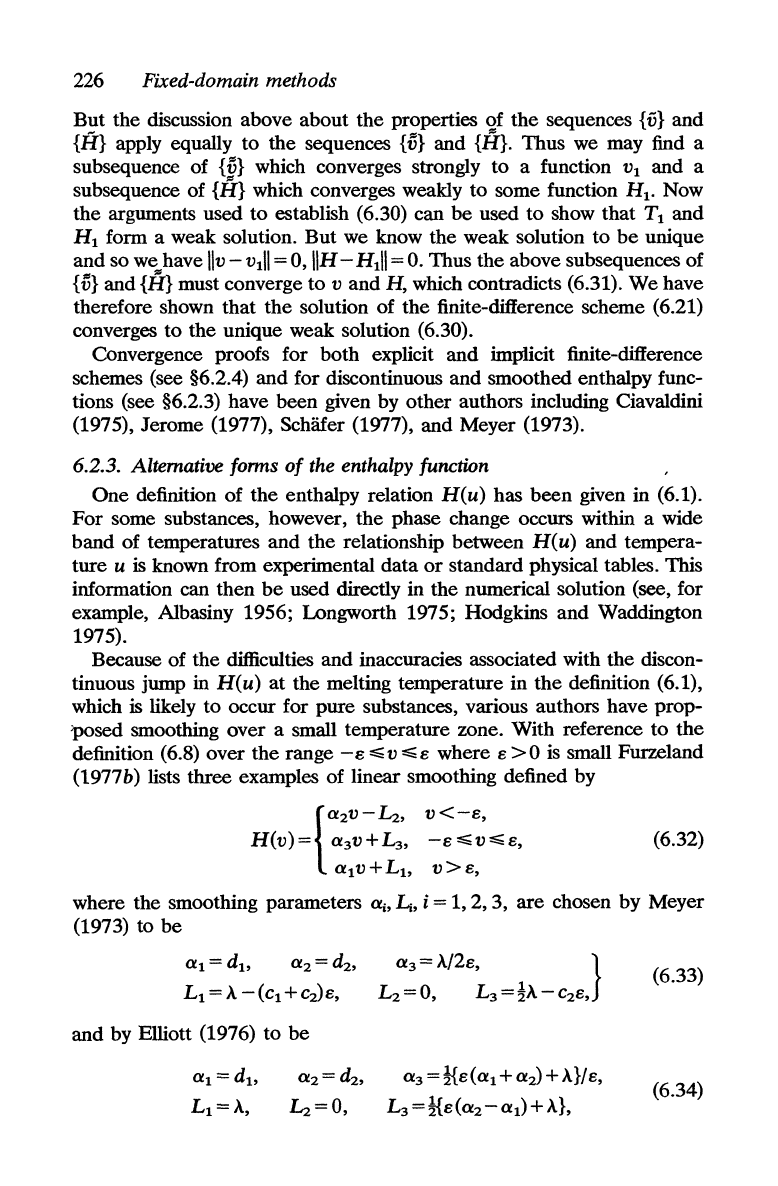
226 Fixed-domain methods
But
the discussion above about
the
properties
Qf
the
sequences
{v}
and
{il}
apply equally
to
the
sequences
{il}
and {H}.
Thus
we may find a
subsequence of
{il}
which converges strongly
to
a function
VI
and a
'"
subsequence of
{H}
which converges weakly
to
some function
HI'
Now
the
arguments used
to
establish (6.30) can
be
used
to
show that TI and
HI
form a weak solution.
But
we know the weak solution
to
be
unique
and
so we have
IIv
-
VIII
=
0,
IIH -
HIli
=
O.
Thus the above subsequences of
{il}
and {Ii} must converge
to
V
and
H, which contradicts (6.31).
We
have
therefore shown
that
the
solution of
the
finite-difference scheme (6.21)
converges
to
the unique weak solution (6.30).
Convergence proofs for
both
explicit
and
implicit finite-difference
schemes (see §6.2.4)
and
for discontinuous
and
smoothed enthalpy func-
tions (see §6.2.3) have been given by
other
authors including Ciavaldini
(1975), Jerome (1977), Schafer (1977), and Meyer (1973).
6.2.3. Alternative forms
of
the enthalpy function
One
definition of
the
enthalpy relation
H(u)
has
been
given in (6.1).
For
some substances, however, the phase change occurs within a wide
band
of temperatures
and
the
relationship between
H(u)
and tempera-
ture
u is known from experimental
data
or
standard physical tables. This
information can
then
be
used directly in the numerical solution (see, for
example, Albasiny 1956; Longworth 1975; Hodgkins
and
Waddington
1975).
Because of
the
difficulties and inaccuracies associated with the discon-
tinuous jump in
H(u)
at
the melting temperature
in
the
definition (6.1),
which is likely
to
occur for
pure
substances, various authors have prop-
posed
smoothing over a small temperature zone. With reference
to
the
definition (6.8) over
the
range - e
,.,.;;
v
,.,.;;
e where e > 0 is small Furzeland
(1977b) lists three examples of linear smoothing defined by
{
a2V-~'
v<-e,
H(v)=
a3v+L3,
-e"";;v"";;e,
alv+Lt.
v>e,
(6.32)
where the smoothing parameters
a;,
1..;,
i = 1, 2, 3,
are
chosen
by
Meyer
(1973) to
be
al
= d
l
, a2 = d
2
,
LI
= A
-(CI
+c2)e,
(6.33)
and by Elliott (1976)
to
be
al
=dt.
a2=d
2
,
a3=!{e(al+a2)+A}/e,
LI
=A,
L
2
=0,
L3=!{e(a2-al)+A},
(6.34)
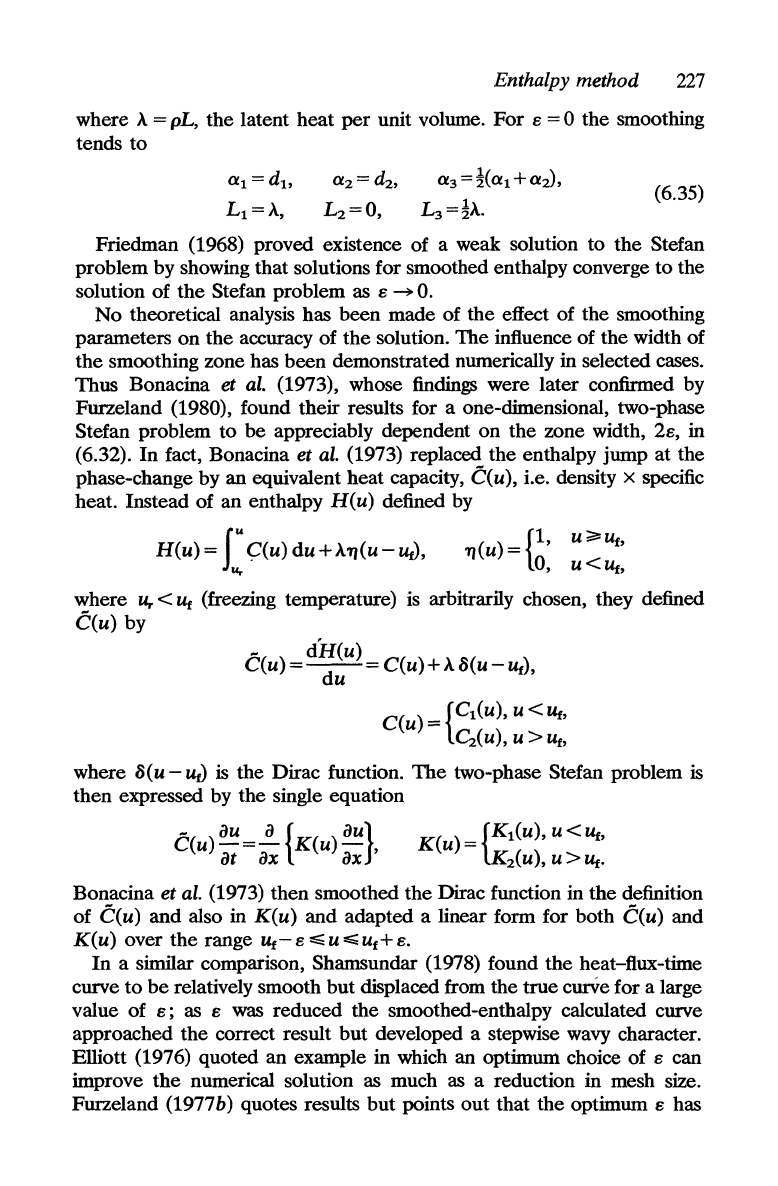
Enthalpy method
227
where A = pL,
the
latent
heat
per
unit volume.
For
e = 0
the
smoothing
tends
to
a2 = d
2
,
a3
=
~(al
+ a:0,
L
2
=O,
L3=~A.
(6.35)
Friedman (1968) proved existence of a weak solution
to
the
Stefan
problem by showing that solutions for smoothed enthalpy converge
to
the
solution of
the
Stefan problem as e
~
o.
No
theoretical analysis has been made of
the
effect of
the
smoothing
parameters
on
the
accuracy of
the
solution.
The
influence of the width of
the
smoothing zone has been demonstrated numerically in selected cases.
Thus Bonacina
et
al.
(1973), whose findings were later confirmed by
Furzeland (1980), found their results for a one-dimensional, two-phase
Stefan problem
to
be
appreciably dependent
on
the
zone width, 2e, in
(6.32).
In
fact, Bonacina et
al.
(1973) replaced
the
enthalpy jump
at
the
phase-change by an equivalent heat capacity,
C(u),
i.e. density x specific
heat. Instead of an enthalpy
H(u)
defined by
f
u
{1,
u~Ur,
H(u)
=
C(u)
du
+
A'Il(U
-
Uf),
'Il(u) = 0
u,
,
u<Ur,
where
u,.
<
Ur
(freezing temperature) is arbitrarily chosen, they defined
C(u)
by
-
dH(u)
C(u)=~=C(u)+A8(u-Ur),
C(u)
=
{C
1
(u),
u<Ur,
C2(u), u >
Ur,
where
8(u
-
Uf)
is the Dirac function.
The
two-phase Stefan problem is
then
expressed by
the
single equation
-
au
a {
au}
C(u)-=-
K(u)-
,
at
ax ax
Bonacina et
al.
(1973) then smoothed
the
Dirac function in
the
definition
of
C(u)
and
also in
K(u)
and adapted a linear form for both
C(u)
and
K(u)
over
the
range
Ur-e
~u~uf+e.
In
a similar comparison, Shamsundar (1978) found
the
heat-flux-time
curve
to
be
relatively smooth
but
displaced from the
true
curVe for a large
value of
e;
as e was reduced
the
smoothed-enthalpy calculated curve
approached
the
correct result
but
developed a stepwise wavy character.
Elliott (1976) quoted an example in which an optimum choice of
e can
improve
the
numerical solution as much as a reduction in mesh size.
Furzeland
(1977b) quotes results
but
points
out
that
the
optimum e has
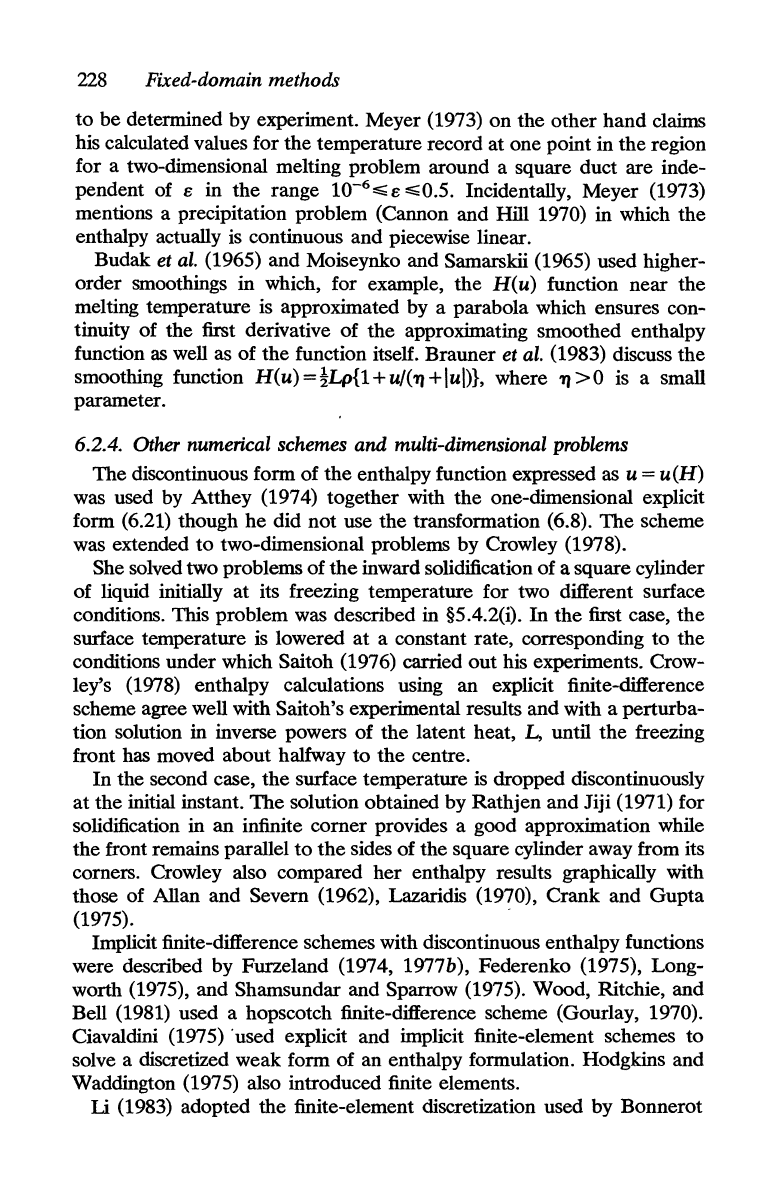
228 Fixed-domain methods
to
be
determined by experiment. Meyer (1973)
on
the
other
hand
claims
his calculated values for
the
temperature record at one point in
the
region
for a two-dimensional melting problem around a square duct are inde-
pendent of
B in
the
range
1O-6~B
~0.5.
Incidentally, Meyer (1973)
mentions a precipitation problem (Cannon and Hill 1970) in which
the
enthalpy actually is continuous and piecewise linear.
Budak
et
al.
(1965) and Moiseynko and Samarskii (1965) used higher-
order smoothings in which, for example,
the
H(u)
function
near
the
melting temperature is approximated by a parabola which ensures con-
tinuity
of
the
first derivative
of
the
approximating smoothed enthalpy
function
as
well as of
the
function itself. Brauner et al. (1983) discuss
the
smoothing function
H(u)=!Lp{l+u/('7I+lul)},
where '71>0 is a small
parameter.
6.2.4. Other numerical schemes and multi-dimensional problems
The
discontinuous form of
the
enthalpy function expressed
as
u =
u(H)
was used by
Atthey
(1974) together with
the
one-dimensional explicit
form (6.21) though
he
did
not
use
the
transformation (6.8).
The
scheme
was extended
to
two-dimensional problems by Crowley (1978).
She solved two problems
of
the
inward solidification of a square cylinder
of liquid initially at its freezing temperature for two different surface
conditions. This problem was described in §5.4.2(i).
In
the
first case,
the
surface temperature is lowered
at
a constant rate, corresponding
to
the
conditions under which Saitoh (1976) carried
out
his experiments. Crow-
ley's (1978) enthalpy calculations using an explicit finite-difference
scheme agree well with Saitoh's experimental results and with a perturba-
tion solution in inverse powers
of
the
latent heat,
L,
until
the
freezing
front has moved about halfway
to
the
centre.
In
the second case,
the
surface temperature is dropped discontinuously
at
the
initial instant.
The
solution obtained by
Rathjen
and
Jiji (1971) for
solidification in
an
infinite corner provides a good approximation while
the
front remains parallel
to
the
sides of
the
square cylinder away from its
corners. Crowley also compared
her
enthalpy results graphically with
those of Allan and Severn (1962), Lazaridis (1970),
Crank
and
Gupta
(1975). .
Implicit finite-difference schemes with discontinuous enthalpy functions
were described
by
Furzeland (1974, 1977b), Federenko (1975), Long-
worth (1975), and Shamsundar and Sparrow (1975). Wood, Ritchie, and
Bell (1981) used a hopscotch finite-difference scheme (Gourlay, 1970).
Ciavaldini (1975) 'used explicit and implicit finite-element schemes
to
solve a discretized weak form
of
an enthalpy formulation. Hodgkins and
Waddington (1975) also introduced finite elements.
Li
(1983) adopted
the
finite-element discretization used by Bonnerot
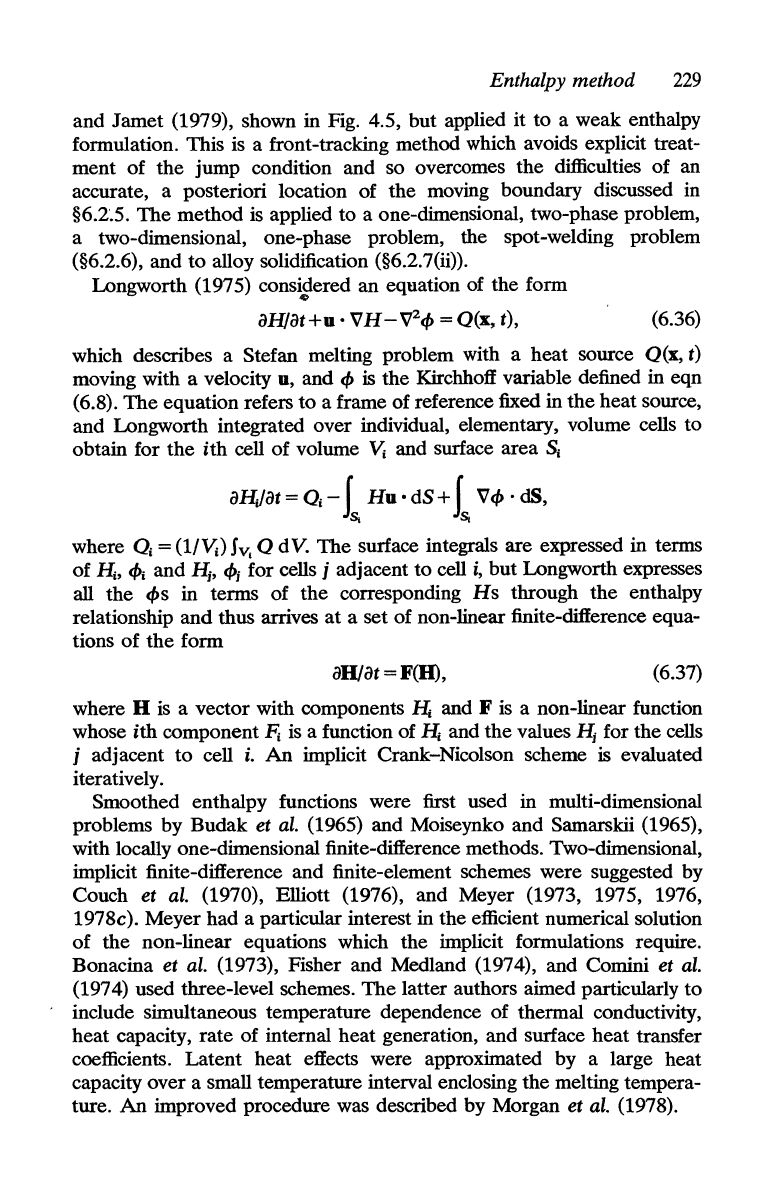
Enthalpy method
229
and
Jamet
(1979), shown in Fig. 4.5,
but
applied it
to
a
weak
enthalpy
formulation. This is a front-tracking method which avoids explicit treat-
ment
of
the
jump
condition
and
so overcomes
the
difficulties
of
an
accurate, a posteriori location
of
the
moving boundary discussed in
§6.2.5.
The
method
is applied
to
a one-dimensional, two-phase problem,
a two-dimensional, one-phase problem, the spot-welding problem
(§6.2.6),
and
to
alloy solidification (§6.2.7(ii)).
Longworth (1975) considered
an
equation of
the
form
...
aHtat+u'
VH
-
VZcf>
= Q(x, t), (6.36)
which describes a Stefan melting problem with a
heat
source Q(x, t)
moving with a velocity u,
and
cf>
is
the
Kirchhoff variable defined
in
eqn
(6.8).
The
equation refers
to
a frame
of
reference fixed in
the
heat
source,
and
Longworth integrated over individual, elementary, volume cells to
obtain for
the
ith cell
of
volume
V;
and surface area
SI
aHJat = Q
i
-J.
Hu'
dS
+J.
Vcf>·
dS,
s. s.
where Q
i
=
(ltV;)
Iv, Q dV.
The
surface integrals are expressed
in
terms
of
H;,
cf>i
and
~,
cf>j
for cells j adjacent
to
cell
i,
but
Longworth expresses
all
the
cf>s
in terms
of
the
corresponding
Hs
through
the
enthalpy
relationship
and
thus arrives
at
a
set
of
non-linear finite-difference equa-
tions
of
the
form
aB/at = F(H),
(6.37)
where H is a vector with components H; and F is a non-linear function
whose
ith
component
Fi
is a function of H; and
the
values
~
for
the
cells
j adjacent
to
cell
i.
An implicit Crank-Nicolson scheme is evaluated
iteratively.
Smoothed enthalpy functions were first used in multi-dimensional
problems
by
Budak
et
aZ.
(1965) and Moiseynko and Samarskii (1965),
with locally one-dimensional finite-difference methods. Two-dimensional,
implicit finite-difference and finite-element schemes were suggested by
Couch et
aZ.
(1970), Elliott (1976), and Meyer (1973, 1975, 1976,
1978c). Meyer had a particular interest in
the
efficient numerical solution
of
the
non-linear equations which
the
implicit formulations require.
Bonacina et
aZ.
(1973), Fisher
and
Medland (1974), and Comini et
aZ.
(1974) used three-level schemes.
The
latter authors aimed particularly
to
include simultaneous temperature dependence
of
thermal conductivity,
heat
capacity,
rate
of
internal
heat
generation, and surface
heat
transfer
coefficients.
Latent
heat
effects were approximated by a large heat
capacity over a small temperature interval enclosing
the
melting tempera-
ture. An improved procedure was described by Morgan et
aZ.
(1978).
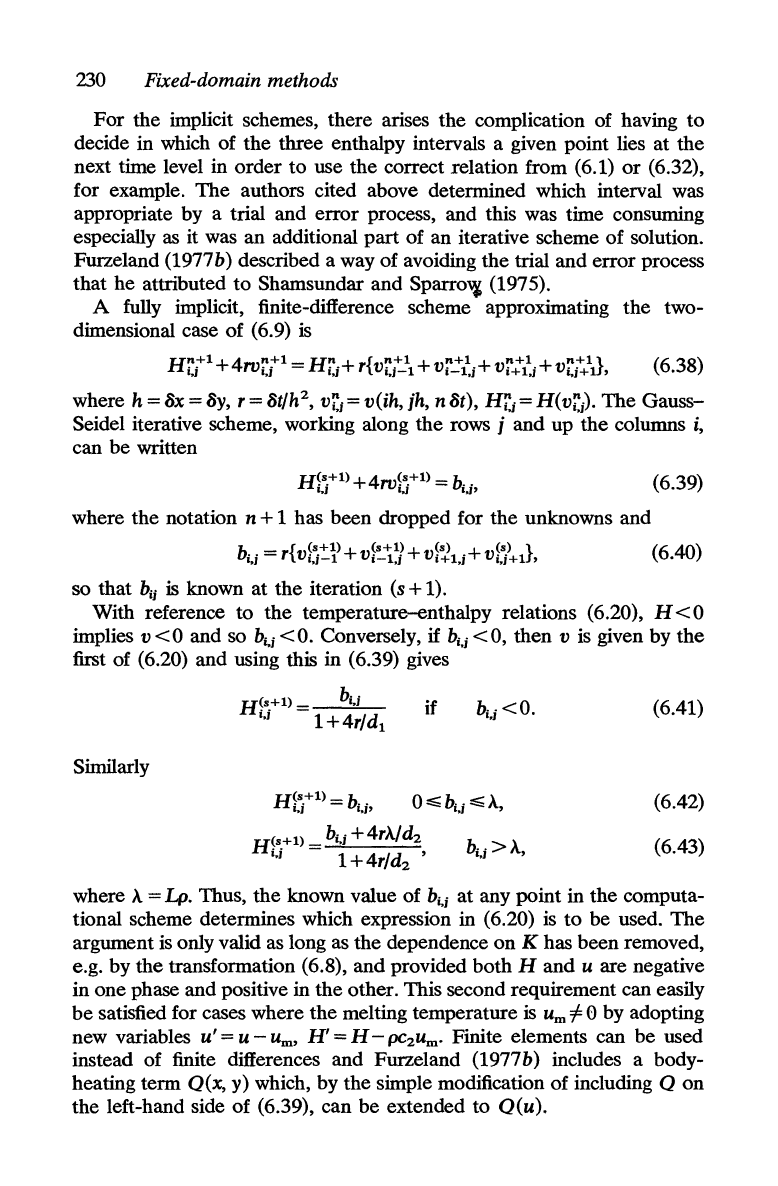
230 Fixed-domain methods
For
the
implicit schemes,
there
arises
the
complication of having
to
decide in which
of
the
three enthalpy intervals a given point lies
at
the
next time level in
order
to
use
the
correct relation from (6.1)
or
(6.32),
for example.
The
authors cited above determined which interval was
appropriate by a trial and
error
process, and this was time consuming
especially as it was
an
additional
part
of
an
iterative scheme
of
solution.
Furzeland (1977b) described a way
of
avoiding
the
trial
and
error
process
that
he
attributed
to
Shamsundar
and
Sparro,¥ (1975).
A fully implicit, finite-difference scheme approximating
the
two-
dimensional case
of
(6.9)
is
H
n+1+4
n+1_Hn
+ {
n+1
+
n+1
+
n+1
+
n+1}
;'i rvi,i -
iJ
r
Vi.J-1
Vi-1.i
Vi+1.i
V;'i+1'
(6.38)
where
h=8x=8y,
r=8tlh
2
,
vi;J=v(ih,jh,
n8t),
HfJ=H(vi;i)'
The
Gauss-
Seidel iterative scheme, working along
the
rows j
and
up
the
columns
i,
can
be
written
where
the
notation n + 1 has been dropped for
the
unknowns and
b
- {
(s+1)
+
(s+1)
+
(s)
+
(s)
}
;'i - r Vi.i-1 Vi-l.i
Vi+1.i
vi.i+1,
so
that
b
ii
is known
at
the
iteration (s + 1).
(6.39)
(6.40)
With reference
to
the
temperature-enthalpy relations (6.20), H
<0
implies v < 0 and so
bi.J
<
O.
Conversely,
if
b
i
•
i
< 0,
then
v is given by
the
first of (6.20) and using this
in
(6.39) gives
H~s.+1)
= b
i
•
i
'J
1
+4rld
1
if
Similarly
H~s.+1)
= b
i
.i
+4rAld
2
'.J
1+4rld
2
'
bi.i>A,
(6.41)
(6.42)
(6.43)
where A
=!.p.
Thus,
the
known value
of
b
i
•
i
at
any
point
in
the
computa-
tional scheme determines which expression in (6.20) is
to
be
used.
The
argument is only valid as long as
the
dependence
on
K has
been
removed,
e.g. by
the
transformation (6.8),
and
provided
both
Hand
U are negative
in
one
phase
and
positive in
the
other. This second requirement can easily
be
satisfied for cases where
the
melting temperature
is
Urn
1=
0 by adopting
new variables
u'
= U - Urn,
H'
= H -
PC2Urn'
Finite elements can
be
used
instead
of
finite differences
and
Furzeland (1977b) includes a body-
heating term Q(x, y) which, by
the
simple modification
of
including Q
on
the
left-hand side
of
(6.39),
can
be
extended
to
Q(u).
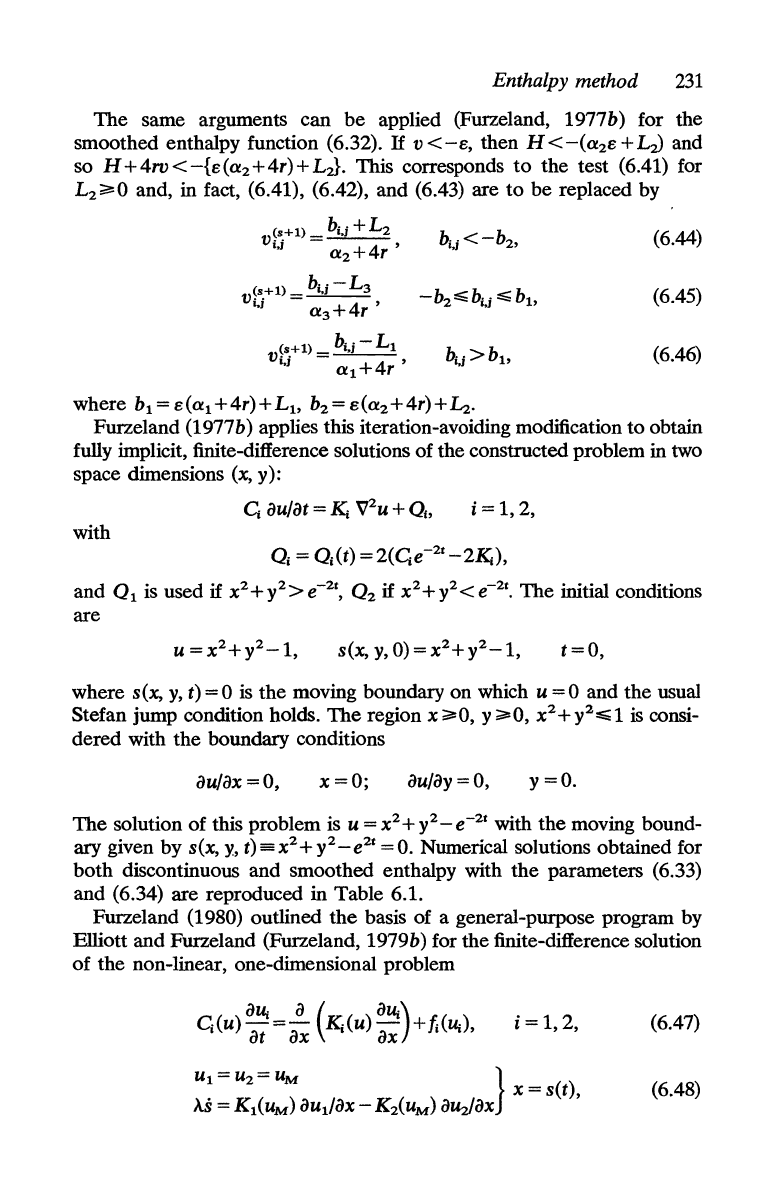
Enthalpy method
231
The
same arguments
can
be
applied (Furzeland, 1977
b)
for the
smoothed enthalpy function (6.32). H
v<-e,
then
H<-(a2e+L~
and
so H +
4",
<
-{
e(
a2 + 4r) + L:J. This corresponds
to
the
test (6.41) for
L2~0
and, in fact, (6.41), (6.42),
and
(6.43)
are
to
be
replaced by
(.+1)
_ bi•
i
+
L2
b
Vi,i
- a2+
4r
'
bi,i<-
2,
(6.44)
(.+1)_
bi,i-
L
3 b b b
v··
- -
2:S:;
iJ:S:;
1>
',J a3+
4r
'
(6.45)
(0+1)
_
b;,i
-
Ll
b b
Vi,i
-
al+
4r
'
i,i>
1>
(6.46)
where b
1
=e(al+4r)+L1> b
2
=e(a2+4r)+Lz.
Furzeland (1977 b) applies this iteration -avoiding modification
to
obtain
fully implicit, finite-difference solutions
of
the
constructed problem in two
space dimensions (x, y):
c;
au/at
=Kt
V
2
u+ Q"
i = 1, 2,
with
Q
i
= Qi(t)
=2(C;e-
2t
-2Kt),
and Q
1
is used
if
x
2
+y2>e-
2t
, Q
2
if
x
2
+y2<e-
2t
.
The
initial conditions
are
t=O,
where s(x,
y,
t)
= 0 is
the
moving boundary
on
which u = 0 and
the
usual
Stefan jump condition holds.
The
region
x~O, y~O,
x2+y2:S:;1 is consi-
dered
with
the
boundary conditions
au/ax
=0,
x=O;
au/ay
=0,
y=O.
The
solution
of
this problem is u = x
2
+y2_e-
2t
with
the
moving bound-
ary given by s(x, y,
t)=x
2
+y2_e
2t
=0.
Numerical solutions obtained for
both
discontinuous and smoothed enthalpy with
the
parameters (6.33)
and (6.34) are reproduced in Table 6.1.
Furzeland (1980) outlined
the
basis of a general-purpose program by
Elliott
and
Furzeland (Furzeland, 1979b) for
the
finite-difference solution
of
the
non-linear, one-dimensional problem
i=1,2,
(6.47)
(6.48)
